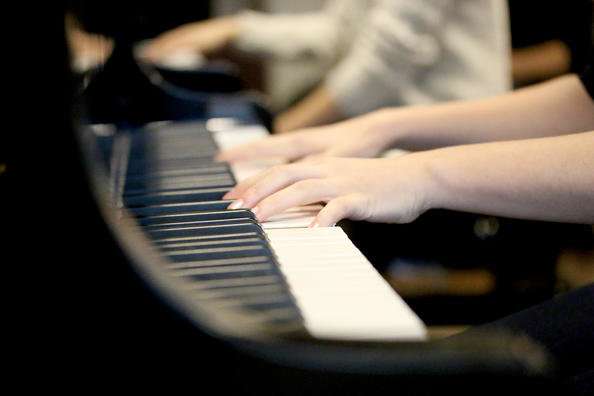Research shows that literacy learning methods may help beginners to read music

Many music students find it difficult to learn to play an instrument, and struggle with music reading. Even after long practice, few children are able to sight read music off the page in the same way they read a book.
"Can this be explained by differences in how they learn to read text and music?" Katarzyna Julia Leikvoll wondered. In March 2017, she defended her Ph.D. thesis in Literacy Studies at the University of Stavanger.
Her Ph.D. thesis focuses on how writing, visual recognition and understanding may provide a more efficient way of learning to read and play music.
Leikvoll examined how beginner piano students learn to read music in the Norwegian extra-curricular music schools. She then compared this to how reading and writing is taught in primary schools.
The researcher points out that text reading and music reading have many similarities.
Similarities in the reading process
In both cases, it is a matter of decoding larger units such as words, chords (several notes played at the same time) and scales (groups of notes moving stepwise) instead of individual letters and notes.
Moreover, we anticipate what the next word or group of notes will be, based on the context. Leikvoll points out that this helps to maintain fluency in reading and playing.
Recognition and understanding
Recognising individual letters and common words is emphasised in Norwegian methods for teaching reading and writing in primary schools. Writing is an integral part of literacy learning. Writing and text comprehension is therefore emphasised in teaching methods.
Other frequently used teaching activities are listening and demonstration by using objects that can be seen and touched. The lesson books also come with detailed instructions for teachers.
The first sentences pupils are presented to usually consist of two or three words, and textbook illustrations help to focus on understanding what is being read.
Understanding is prioritised right from the beginning as the pupils have to reflect upon whether or not the illustration corresponds to the text.
Learning to read music
The most popular piano methods for beginners are on the other hand usually based on using single notes as commands to the fingers on which keys to press.
"Piano teachers explain music reading to beginners by pointing to the sheet music saying 'This is note C, D, E. Here are the C, D and E keys. Now play!' No child is taught how to read by being told 'This is the letter A. This is B. This is C. Now read!', " Leikvoll points out.
"Furthermore, there are no exercises for writing music and no information as to what is important to look for in an unfamiliar sheet of music. Notes are not explained as visual symbols representing particular sounds, but as commands on which keys to press," she continues.
Lack of writing and understanding
Katarzyna Julia Leikvoll calls for exercises in music writing and focus on understanding how harmonic relationships between groups of notes form a kind of scaffold which the piano piece is built upon. Then harmonic structures can be recognised as meaningful units when you read and play unfamiliar music.
"This approach seems to be absent in the most popular piano methods for beginners," she says.
Harmony involves set rules for what goes together, the reason why, and what to expect next.
"If you learn these rules, reading music becomes more meaningful. You will see the big picture and think harmony instead of individual notes," the researcher says.
A new method for teaching music reading
Based on the methods for teaching reading and writing used in Norwegian primary schools, Leikvoll has developed a piano method for beginners called "Listen, write, play". It includes a lesson book, an exercise book and a detailed teacher's guide.
The method was tested out experimentally during a school year on a number of piano students and teachers.
How to achieve the best learning
Much time was spent playing by ear and learning about the basic harmonic structure of pieces. In addition, the method emphasises automatic recognition of single notes and being able to read larger units. The students also spent time writing down familiar and unfamiliar melodies.
The research showed that students' skills in reading and playing an unknown piece of music was related to their ability to immediately recognise single notes. There was also a connection between how the pupils could explain the meaning of musical symbols on a sheet of music and their ability to write down simple, unfamiliar melodies played on the piano.
Keeping the same music teacher is important
It turned out that the pupils that achieved the best results also were the ones with the most lessons with their regular music teacher.
"Frequent and regular lessons with a teacher who knew the students well gave the best results in learning to read music. Other important activities were writing music; single notes, familiar and unfamiliar melodies, and composition," Leikvoll explains.
Discussing patterns
Discussing the different elements of a sheet music, for example seeing when patterns recur, also proved to be important.
The location of a note on a specific line or in a space between two lines decides the pitch.
"My research showed that students who could explain things such as 'Note G lies on the second line. A note that is white on the inside lasts for two beats and you must count to two' did better than students who were unable to explain such things orally," Leikvoll says.
For beginner piano students to acquire good music reading skills the researchers recommends varied teaching activities, including writing music, talking about the meaning of musical symbols, and using body movements.
"These teaching activities enabled the children to quickly recognise pitch and rhythm patterns," she says.



















